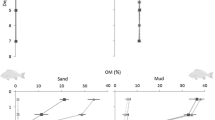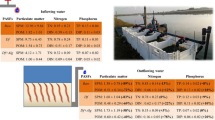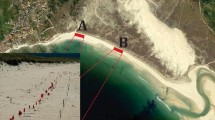Abstract
Sandy beaches provide a number of ecosystem services, such as the breakdown of organic matter (OM), nutrient mineralisation and water filtration. These environments may be considered as biofilters, able to regulate the transport and transformation of OM from land to sea and vice-versa, due to the porous structure of the sediment and the colonisation by microorganisms. The efficiency of OM recycling performed by enzymatic activities (EAs) was evaluated in three beaches of the NW Mediterranean Sea, characterised by different anthropogenic pressure (urbanisation), and morphodynamic characteristics (exposition to waves). The sampling was focused on the area that includes the swash zone and the wet emerged beach. Urbanisation significantly influenced EAs, leading to a decoupling between the lipolytic EAs and the lipid content of sediment. Natural and anthropogenic lipids, showing higher turnover times than other OM (proteins), accumulated in the sediment, notwithstanding the very high lipolytic activities. In the sheltered side of the urbanised sites, significant correlations between EAs, sedimentary OM and seawater inorganic nutrients were recorded, confirming the biofilter activity. In the exposed sites, the wave action increased the exchanges with the sea by water flushing inside the sediment, and EAs were related mainly to salinity. Especially in the least urbanised beach, coarse texture, higher pendency and heterogeneity of the sediment decreased the biofilter activity, allowing photosynthetic producers to increase their biomass. In this case, the beach hosted production of fresh OM, contributing to fulfil the trophic web requirements.






Similar content being viewed by others
References
Araujo MC, Costa M (2007) An analysis of the riverine contribution to the solidwastes contamination of an isolated beach at the Brazilian Northeast. Manag Environ Qual 18:6–12
Avery GB Jr, Kieber RJ, Taylor KJ, Dixon JL (2012) Dissolved organic carbon release from surface sand of a high energy beach along the southeastern coast of North Carolina, USA. Mar Chem 132–133:23–27
Bligh EG, Dyer WJ (1959) A rapid method for total lipid extraction and purification. Can J Biochem Physiol 37:911–917
Boetius A, Lochte K (1996) Effect of organic enrichments on hydrolytic potentials and growth of bacteria in deep-sea sediments. Mar Ecol Prog Ser 140:239–250
Brown AC, McLachlan A (2002) Sandy shore ecosystems and the threats facing them: some predictions for the year 2025. Environ Conserv 29:62–77
Caddy JF, Defeo O (2003) Enhancing or restoring the productivity of natural populations of shellfish and other marine invertebrate resources. FAO Fish Tech Pap 448, FAO, Rome
Caruso G, Monticelli L, Azzaro F, Azzaro M, Decembrini F, La Ferla R, Leonardi M, Zaccone R (2005) Dynamics of extracellular enzymatic activities in a shallow Mediterranean ecosystem (Tindari Ponds, Sicily). Mar Freshw Res 56:173–188
Christodoulou S, Marty JC, Miquel JC, Volkman JK, Rontani JF (2009) Use of lipids and their degradation products as biomarkers for carbon cycling in the northwestern Mediterranean sea. Mar Chem 113:25–40
Clarke KR, Warwick RM (2001) Changes in marine communities: an approach to statistical analysis and interpretation, 2nd edn. PRIMER-E, Plymouth
Cooper JAG, McKenna J (2008) Social justice in coastal erosion management: the temporal and spatial dimensions. Geoforum 39:294–306
Covazzi Harriague A, Albertelli G (2007) Environmental factors controlling macrofaunal assemblages on six microtidal beaches of the Ligurian sea (NW Mediterranean). Estuar Coast Shelf S 73:8–16
Covazzi Harriague A, Gaozza L, Montella A, Misic C (2006) Benthic communities on a sandy Ligurian beach (NW Mediterranean). Hydrobiologia 571:383–394
Defeo O, McLachlan A, Schoeman DS, Schlacher T, Dugan J, Jones A, Lastra M, Scapini F (2009) Threats to sandy beach ecosystems: a review. Estuar Coast Shelf S 81:1–12
Derraik JGB (2002) The pollution of the marine environment by plastic debris: a review. Mar Pollut Bull 44:842–852
Duflos M, Goutx M, Van Wambeke F (2009) Determination of lipid degradation by marine lipase-producing bacteria: critical evaluation of lipase activity assays. Lipids 44:1113–1124
Fabiano M, Danovaro R, Fraschetti S (1995) Temporal trend analysis of the elemental composition of the sediment organic matter in subtidal sandy sediments of the Ligurian sea (NW Mediterranean): a three years study. Cont Shelf Res 15:1453–1469
Folk R, Ward WC (1957) Brazos river bar (Texas): a study in the significance of grain size parameters. J Sediment Res 27:3–26
Galois R, Blanchard G, Seguignes M, Huet V, Joassard L (2000) Spatial distribution of sediment particulate organic matter on two estuarine mudflats: a comparison between Marennes-Oléron bay (France) and the Humber estuary. Cont Shelf Res 20:1199–1217
Griggs GB (2005) The impacts of coastal armoring. Shore Beach 73:13–22
Hansen HP, Grasshoff K (1983) Automated chemical analysis. In: Grassoff K, Ehrhardt M, Kremling K (eds) Methods of seawater analysis. Verlag Chemie, Weinheim, pp 347–379
Hartree EF (1972) Determination of proteins: a modification of the Lowry method that gives a linear photometric response. Anal Biochem 48:422–427
Hobbie JE, Daley RJ, Jasper S (1977) Use of Nuclepore filters for counting bacteria by fluorescence microscopy. Appl Environ Microb 33:1225–1228
Hoppe HG (1983) Significance of exoenzymatic activities in the ecology of brackish water: measurement by means of methylumbelliferyl-substrates. Mar Ecol-Prog Ser 11:299–308
Hoppe HG (1993) Use of fluorogenic model substrates for extracellular enzyme activity (EEA) measurement of bacteria. In: Kemp PF, Sherr BF, Sherr EB, Cole JJ (eds) Handbook of methods in aquatic microbial ecology. Lewis Publishers, Boca Raton, pp 423–431
Hoppe H-G, Üllrich S (1999) Profiles of ectoenzymes in the Indian ocean: phenomena of phosphatase activity in themesopelagic zone. Aquat Microb Ecol 19:129–138
Incera M, Cividanes SP, Lastra M, López J (2003) Temporal and spatial variability of sedimentary organic matter in sandy beaches on the northwest coast of the Iberian Peninsula. Estuar Coast Shelf S 58:55–61
Innocenti L, Pranzini E (1993) Geomorphological evolution and sedimentology of the Ombrone river delta, Italy. J Coastal Res 9:481–493
Irvine GV, Mann DH, Short JW (2006) Persistence of 10-year old Exxon Valdez oil on Gulf of Alaska beaches: the importance of boulder-armoring. Mar Pollut Bull 52:1011–1022
Köster M, Dahlke S, Meyer-Reil L-A (2005) Microbial colonization and activity in relation to organic carbon insediments of hypertrophic coastal waters (Nordrügensche Bodden, Southeren Baltic sea). Aquat Microb Ecol 39:69–83
Lorenzen C, Jeffrey J (1980) Determination of chlorophyll in seawater. UNESCO Tech Pap Mar Sci 35:1–20
Mardon D, Stretch D (2004) Comparative assessment of water quality at Durban beaches according to local and international guidelines. Water SA 30:317–324
Marsh BJ, Weinstein DB (1966) Simple charring method for determination of lipids. J Lipid Res 7:574–576
Meyer-Reil L-A, Köster M (2000) Eutrophication of marine waters: effects on benthic microbial communities. Mar Pollut Bull 41:255–263
Misic C, Covazzi Harriague A (2007) Enzymatic activity and organic substrates on a sandy beach of the Ligurian sea NW Mediterranean subjected to anthropogenic pressure. Aquat Microb Ecol 47:239–251
Misic C, Covazzi Harriague A (2008) Organic matter recycling in a shallow coastal zone (NW Mediterranean): the influence of local and global climatic forcing and organic matter lability on hydrolytic enzyme activity. Cont Shelf Res 28:2725–2735
Misic C, Covazzi Harriague A (2013) Urbanised beaches of the Ligurian coastal area (NW Mediterranean): a classification based on organic-matter characteristics and hydrolytic enzymatic activities. Mar Environ Res 87–88:103–111
Misic C, Fabiano M (2005) Enzymatic activity on sandy beaches of the Ligurian sea NW Mediterranean. Microb Ecol 49:513–522
Misic C, Covazzi Harriague A, Trielli F (2011) Organic matter recycling in a beach environment influenced by sunscreen products and increased inorganic nutrient supply (Sturla, Ligurian sea, NW Mediterranean). Sci Total Environ 409:1689–1696
Mudryk Z, Podgórska B (2005) Spatial variability in the activity of hydrolytic enzymes in a marine beach (southern Baltic sea). Pol J Ecol 53:255
Mudryk ZJ, Podgórska B, Ameryk A (2001) Bacteriological characterisation of a Baltic sandy beach in summer. Ecohydrol Hydrobiol 1:503–509
Patel AB, Fukami K, Nishijima T (2000) Regulation of seasonal variability of aminopeptidase activities in surface and bottom waters on Uranouchi Inlet, Japan. Aquat Microb Ecol 21:139–149
Perlińsky P, Mudryk ZJ (2016) Activity of extracellular enzymes on the marine beach differing in the level of antropopressure. Environ Monit Assess 188(3):188
Rusch A, Huettel M, Reimers CE, Taghon GL, Fuller CM (2003) Activity and distribution of bacterial populationsin Middle Atlantic Bight shelf sands. FEMS Microbiol Ecol 44:89–100
Sala MM, Karner M, Arin L, Marrase C (2001) Measurement of ectoenzyme activities as an indication ofinorganic nutrient imbalance in microbial communities. Aquat Microb Ecol 23:301–311
Salvo V-S, Marin V, Misic C, Moreno M, Fabiano M (2003) Ecological response to the wave action in the swash zone of aLigurian beach (NW Mediterranean). In: Proceedings of the 6th international conference on the Mediterranean coastal environment MEDCOAST 03: Coastal Ecosystems, Ravenna, 7–11 October 2003
Schlacher TA, Dugan J, Schoeman DS, Lastra M, Jones A, Scapini F, McLachlan A, Defeo O (2007) Sandy beaches at the brink. Divers Distrib 13:556–560
Speybroeck J, Bonte D, Courtens W, Gheskiere T, Grootaert P, Maelfait J-P, Mathys M, Provoost S, Sabbe K, Stienen WM, Van Lancker V, Vincx M, Degraer S (2006) Beach nourishment: an ecologically sound coastal defence alternative? A review. Aquat Conserv 16:419–435
Suderman K, Thistle D (2003) Spills of fuel oil #6 and Orimulsion can have indistinguishable effects on the benthic meiofauna. Mar Pollut Bull 46:49–55
Sun X, Zhou H, Hua E, Xu S, Cong B, Zhang Z (2014) Meiofauna and its sedimentary environment as an integrated indication of anthropogenic disturbance to sandy beach ecosystems. Mar Pollut Bull 88:260–267
Tomaselli A, Spinetti I, De Falco L, Brandino A, Grita M (2008) Studio relativo alla disponibilità idrica dei corpi idrici non significativi ricadenti nel versante ligure Il bacino del torrente Sturla Provincia di Genova, p 72. https://cartogis.cittametropolitana.genova.it/cartogis/pdb/bilancio_idrico/bilancio_idrico/ambito14/testi/relazione%20sturla.pdf. Accessed 2014
Zuur AF, Ieno EN, Smith GM (2007) Analysing ecological data. Springer, New York
Acknowledgements
This work was funded by the project “Environmental quality of urban and urbanised beaches of the Ligurian coastal area and ecological effects on benthic communities”, in the framework of the Research Projects of the University of Genova, 2012. We thank the three reviewers.
Author information
Authors and Affiliations
Contributions
All authors contributed to the study conception and design. Material preparation, data collection and analysis were performed by CM and ACH. The first draft of the manuscript was written by CM and all authors commented on previous versions of the manuscript. All authors read and approved the final manuscript.
Corresponding author
Ethics declarations
Conflict of interest
The authors declare that they have no conflict of interest.
Additional information
Responsible Editor: M. Huettel.
Publisher's Note
Springer Nature remains neutral with regard to jurisdictional claims in published maps and institutional affiliations.
Reviewed by M. A Kähkönen, H. Zhou and an undisclosed expert.
Rights and permissions
About this article
Cite this article
Misic, C., Covazzi Harriague, A. Beach sand as a biofilter: enzymatic activity and organic matter relationships in oligotrophic sites differently influenced by anthropogenic pressures and morphodynamism. Mar Biol 167, 24 (2020). https://doi.org/10.1007/s00227-019-3641-y
Received:
Accepted:
Published:
DOI: https://doi.org/10.1007/s00227-019-3641-y




